Hallways take a beating with every step and spill that hits the floor. Foot traffic can wear down surfaces and lead to damage that slashes floor lifespan by up to 50 percent if left unprotected. You might think a simple mat is just there to look nice or catch a bit of dirt. Turns out, these mats act as frontline defenders, stopping injuries and saving thousands in cleaning and repair costs before you even notice a problem.
Table of Contents
- What Are Floor Mats For Hallways?
- Why Floor Mats Matter For Safety And Maintenance
- How Floor Mats Work To Improve Indoor Environments
- Key Features To Consider In Floor Mats For Hallways
- Real-World Applications Of Floor Mats In Various Settings
Quick Summary
| Takeaway | Explanation |
|---|---|
| Strategic floor mats enhance safety. | Properly positioned mats create traction and absorb moisture, reducing slip and fall risks in various environments. |
| Floor mats extend flooring lifespan. | By trapping dirt and moisture, mats prevent damage, extending the life of floors by up to 50%. |
| Evaluate mat materials before purchase. | Selecting mats resistant to moisture and wear ensures durability and effectiveness in high-traffic areas. |
| Ergonomic mats improve comfort. | Cushioned mats reduce physical strain for those who stand for long periods, enhancing overall workplace conditions. |
| Mats can transform indoor environments. | Modern mats serve multiple functions, effectively managing safety, cleanliness, and aesthetic needs in diverse settings. |
What are Floor Mats for Hallways?
Floor mats for hallways are specialized protective coverings designed to shield flooring surfaces from wear, dirt, and potential damage caused by foot traffic. These functional accessories serve multiple purposes beyond simple floor protection, acting as critical elements in maintaining cleanliness, safety, and aesthetic appeal in commercial and residential spaces.
Below is a comparison of common hallway floor mat types, summarizing their key characteristics to help you choose the best option for your specific needs.
| Mat Type | Moisture Absorption | Durability | Ideal Environment | Ease of Cleaning |
|---|---|---|---|---|
| Carpet | High | Moderate | High-moisture, dirt-prone hallway | Regular vacuuming |
| Rubber | Low | Very High | Heavy-traffic, slip-prone areas | Easy, wipe or hose off |
| Vinyl | Low | High | Light-moderate traffic, dry areas | Very easy |
Types of Hallway Floor Mats
Different hallway floor mats are engineered to address specific environmental and functional needs. Our comprehensive guide to indoor entrance floor mats explores these variations in depth. The primary categories include:

- Carpet Mats: Soft, absorbent surfaces ideal for trapping moisture and reducing dirt tracking
- Rubber Mats: Highly durable options perfect for heavy traffic areas with superior slip resistance
- Vinyl Mats: Lightweight, easy to clean surfaces suitable for minimal moisture environments
Functional Characteristics
According to safety research from the CDC, hallway floor mats are engineered with specific technical characteristics to maximize performance. Key functional elements include:
- Enhanced moisture absorption capabilities
- Textured surfaces to scrape debris from shoe soles
- Chemical resistance for long term durability
- Ergonomic design to reduce slip and fall risks
These mats function as critical protective barriers, intercepting dirt, water, and debris before they can spread across interior flooring surfaces.
The table below organizes the main functional characteristics of hallway floor mats, providing a concise overview of their role in everyday performance and indoor protection.
| Functional Characteristic | Purpose/Benefit |
|---|---|
| Enhanced moisture absorption | Captures and contains spills and tracked-in water |
| Textured surfaces | Scrapes debris from shoes to reduce indoor dirt |
| Chemical resistance | Maintains durability against cleaning agents and spills |
| Ergonomic design | Reduces slip risks, improves overall safety |
By strategically positioning floor mats in hallways, businesses and homeowners can significantly reduce cleaning costs, minimize floor maintenance, and create safer walking environments.
Why Floor Mats Matter for Safety and Maintenance
Floor mats play a crucial role in creating safe, clean, and well-maintained environments by addressing multiple critical challenges associated with foot traffic and floor preservation. Their importance extends far beyond simple aesthetic considerations, offering substantial benefits for both residential and commercial spaces.
Safety Prevention Strategies
A practical guide to anti slip floor mats highlights the fundamental safety advantages of strategic floor mat placement. Slip and fall accidents represent a significant risk in many environments, with potential consequences ranging from minor injuries to serious workplace incidents. Floor mats provide critical intervention by:
- Creating textured surfaces that increase traction
- Absorbing moisture that could cause slippery conditions
- Reducing the potential for unexpected floor surface transitions
- Providing visual and physical warnings about potential hazard zones
Maintenance and Preservation
Research from the National Floor Safety Institute indicates that proper floor protection can extend flooring lifespan by up to 50%. Floor mats act as a primary defense mechanism against several maintenance challenges:
- Trapping dirt and debris before it damages floor surfaces
- Reducing wear and tear from constant foot traffic
- Minimizing scratching and scuffing on expensive flooring materials
- Creating a barrier against moisture that can cause long term damage
By intercepting potential sources of floor degradation, hallway floor mats transform from simple accessories into strategic maintenance tools. They represent a proactive approach to protecting valuable flooring investments, reducing long term repair and replacement costs while simultaneously enhancing safety and aesthetic appeal.

How Floor Mats Work to Improve Indoor Environments
Floor mats operate as sophisticated environmental management systems, employing intricate design principles to transform indoor spaces through strategic physical interventions. Their functionality extends well beyond simple floor covering, creating complex interactions that actively mitigate environmental challenges.
Moisture and Debris Interception
A practical guide to choosing indoor floor mats reveals the nuanced mechanisms of mat performance. Moisture management represents a critical function, with mats engineered to capture and contain liquid and particulate contaminants through specialized surface technologies:
- Microfiber and absorbent material layers trap water molecules
- Textured surfaces scrape and collect dirt from shoe soles
- Raised edge designs prevent liquid spread across floor surfaces
- Multiple material layers provide progressive filtration
Ergonomic and Environmental Impact
According to occupational safety research from NIOSH, floor mats contribute significantly to worker comfort and environmental quality. Functional design elements transform these seemingly simple accessories into comprehensive workplace solutions:
- Cushioning materials reduce physical strain during prolonged standing
- Temperature insulation prevents cold floor surface discomfort
- Sound absorption capabilities decrease ambient noise levels
- Antimicrobial treatments inhibit bacterial and fungal growth
By creating multiple layers of environmental protection, floor mats function as dynamic systems that simultaneously address safety, cleanliness, comfort, and maintenance requirements in indoor spaces.
Key Features to Consider in Floor Mats for Hallways
Selecting the right floor mat involves careful evaluation of multiple performance characteristics that determine effectiveness, durability, and overall functionality. Understanding these critical features enables businesses and property managers to make informed decisions that optimize safety, maintenance, and aesthetic considerations.
This table highlights the key features to evaluate when selecting floor mats for hallways, helping you prioritize factors that impact effectiveness, safety, and maintenance.
| Feature | Why It Matters |
|---|---|
| Material resistance | Ensures mat withstands moisture and chemicals |
| Durability | Withstands heavy foot traffic over time |
| Slip resistance | Reduces risk of slips and falls |
| Moisture absorption | Prevents water damage and spread on floors |
| Structural integrity | Maintains mat shape and function long-term |
Material and Construction Quality
Elevate safety and slash costs with the right floor mats entrance emphasizes the importance of strategic material selection. Critical material considerations include:
- Resistance to moisture and chemical degradation
- Durability under consistent heavy foot traffic
- Ability to maintain structural integrity over extended periods
- Compatibility with specific environmental conditions
Performance and Functional Specifications
Research from OSHA workplace safety guidelines highlights essential performance metrics for hallway floor mats. Key functional requirements encompass:
- Minimum slip resistance coefficient
- Effective moisture absorption capabilities
- Rapid debris removal efficiency
- Temperature and wear tolerance range
Beyond basic protective functions, advanced floor mats incorporate sophisticated design elements that transform them from simple floor coverings into comprehensive environmental management systems. By prioritizing material quality, performance specifications, and adaptability, organizations can select floor mats that provide maximum protection, enhance safety, and reduce long term maintenance expenses.
Real-World Applications of Floor Mats in Various Settings
Floor mats serve critical functions across diverse environments, adapting their protective capabilities to meet unique operational requirements. Their versatility allows them to address specific challenges in different professional and institutional contexts, transforming from simple floor coverings into strategic environmental management tools.
Commercial and Institutional Environments
A practical guide to custom floor mats reveals the nuanced applications of specialized mat solutions. Institutional deployment strategies demonstrate remarkable performance across multiple sectors:
- Healthcare facilities reducing cross contamination risks
- Educational institutions managing high traffic entry zones
- Corporate offices creating professional and clean first impressions
- Hospitality venues maintaining aesthetic and safety standards
Industrial and Specialized Applications
According to microbial contamination research, floor mats play a significant role in environmental hygiene and safety management. Critical performance domains include:
- Manufacturing plants preventing equipment damage from debris
- Laboratories maintaining sterile environment protocols
- Food processing facilities ensuring strict sanitation standards
- Warehouses reducing slip and fall workplace accidents
By strategically implementing specialized floor mats, organizations can simultaneously address multiple operational challenges including safety, cleanliness, maintenance, and professional presentation. The sophisticated design of modern floor mats transforms them from simple protective accessories into comprehensive environmental management solutions.
Transform Your Hallway with Trusted Floor Protection from Mats4U
If you are worried about constant dirt, moisture, and wear damaging your hallways, you are not alone. As highlighted in this article, unsafe walkways, cleaning headaches, and worn-down floors are major concerns for businesses and property managers. Hallway mats are essential for creating safer spaces, reducing maintenance costs, and keeping your entryways looking their best. Our Indoor Mats are crafted to trap dirt, absorb moisture, and stand up to heavy traffic, addressing the exact challenges you face every day.
Do not let hallway hazards or costly repairs slow down your business. Visit Mats4U.com now to explore our full selection of Commercial Mats. Shop today and experience durable solutions that keep your floors cleaner, safer, and ready for whatever your day brings.
Frequently Asked Questions
What are floor mats for hallways and why are they important?
Floor mats for hallways are protective coverings that shield flooring from wear and dirt due to foot traffic. They maintain cleanliness, safety, and enhance the aesthetic appeal in both commercial and residential spaces.
What types of hallway floor mats are available?
Common types of hallway floor mats include carpet mats, rubber mats, and vinyl mats. Each type is designed for specific needs, such as moisture absorption, durability, and ease of cleaning.
How do floor mats contribute to safety in indoor environments?
Floor mats improve safety by providing textured surfaces that increase traction, absorbing moisture to prevent slips, and offering visual cues about potential hazards, thereby reducing the risk of slip and fall accidents.
What features should I consider when choosing hallway floor mats?
Key features include material quality (moisture and chemical resistance), slip resistance, moisture absorption capabilities, and durability under heavy foot traffic. These factors influence the mat’s overall effectiveness, safety, and maintenance needs.







